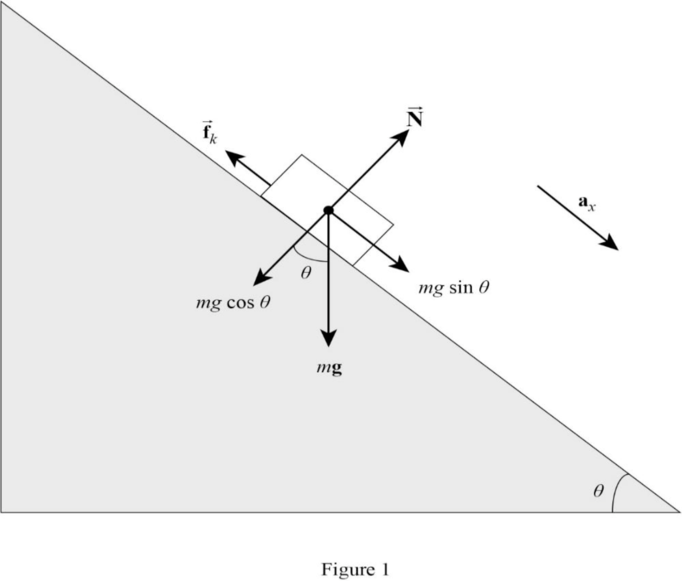
Concept explainers
(a)
The amount of energy dissipated by friction.
(a)
Answer to Problem 100P
The amount of energy dissipated by friction is 935 J_.
Explanation of Solution
Figure 1 represents the free body diagram of the crate.

For an isolated system the total energy of the system (the sum of mechanical energy and its internal energy) is conserved.
ΔK+ΔU+ΔEint=0
Here, ΔK is the change in kinetic energy, ΔU is the change in potential energy, and ΔEint is the change in internal energy of the system.
In this situation, the work done by the frictional force is equal to the change in internal energy of the system.
The above equation is reduced to.
(12mv2f−12mv2i)+mgΔy+ΔEint=0
Here, ΔEint is the energy dissipated by friction, m is the mass of the crate, g is the acceleration due to gravity, and Δy is the distance travelled along the incline.
Since the final velocity of the crate is zero and the distance travelled along incline is given by −dsinθ, the above equation is reduced to
−12mv2i−mgdsinθ+ΔEint=0 (I)
Here, d is the distance travelled along the incline.
Rearrange the above equation.
ΔEint=12mv2i+mgdsinθ (II)
Conclusion:
Substitute 100 kg for m, 2 m/s for vi, 9.8 m/s2 for g, 1.5 m for d, and 30° for θ in equation (I), to find ΔEint.
ΔEint=12(100 kg)(2 m/s)2−(100 kg)(9.8 m/s2)(1.5 m)sin30°=935 J
Therefore, the amount of energy dissipated by friction is 935 J_.
(b)
The coefficient of the sliding friction.
(b)
Answer to Problem 100P
The coefficient of the sliding friction is 0.73_.
Explanation of Solution
Write the expression for net force acting along y direction.
∑Fy=0
Apply the above condition in Figure 1.
N−mgcosθ=0N=mgcosθ (III)
Write the expression for internal energy dissipated by friction.
ΔEfric=μkNd
Here, μk is the coefficient of kinetic friction, N is the normal force, and d is the distance travelled along the incline.
Use the above equation in equation (III).
ΔEfric=μkmgcosθd
Rearrange the above equation to find μk.
μk=ΔEfricmgdcosθ (IV)
Conclusion:
Substitute 935 J for ΔEint, 100 kg for m, 9.8 m/s2 for g, 1.5 m for d, and 30° for θ in equation (IV), to find μk.
μk=935 J(100 kg)(9.8 m/s2)(1.5 m)cos30°=0.73
Therefore, the coefficient of the sliding friction is 0.73_.
Want to see more full solutions like this?
Chapter 6 Solutions
COLLEGE PHYICS
- A golf ball is struck with a velocity of 20 m/s at point A as shown below (Figure 4). (a) Determine the distance "d" and the time of flight from A to B; (b) Determine the magnitude and the direction of the speed at which the ball strikes the ground at B. 10° V₁ = 20m/s 35º Figure 4 d Barrow_forwardThe rectangular loop of wire shown in the figure (Figure 1) has a mass of 0.18 g per centimeter of length and is pivoted about side ab on a frictionless axis. The current in the wire is 8.5 A in the direction shown. Find the magnitude of the magnetic field parallel to the y-axis that will cause the loop to swing up until its plane makes an angle of 30.0 ∘ with the yz-plane. Find the direction of the magnetic field parallel to the y-axis that will cause the loop to swing up until its plane makes an angle of 30.0 ∘ with the yz-plane.arrow_forwardA particle with a charge of − 5.20 nC is moving in a uniform magnetic field of (B→=−( 1.22 T )k^. The magnetic force on the particle is measured to be (F→=−( 3.50×10−7 N )i^+( 7.60×10−7 N )j^. Calculate the y and z component of the velocity of the particle.arrow_forward
- Pls help ASAParrow_forwardPls help ASAParrow_forward9. When an electron moves into a uniform and perpendicular magnetic field, it will.. a. Accelerate parallel to the magnetic Field until it leaves b. Accelerate in a circular path c. Accelerate perpendicular to both the magnetic field and its original direction d. Repel back into the electric field 10. If a proton at rest is placed in a uniform magnetic field with no electric or gravitational field around, the proton will…….. a. Accelerate in the direction of the magnetic field b. Accelerate in a direction perpendicular to the magnetic field c. Move in a circular path d. Not acceleratearrow_forward
 College PhysicsPhysicsISBN:9781305952300Author:Raymond A. Serway, Chris VuillePublisher:Cengage Learning
College PhysicsPhysicsISBN:9781305952300Author:Raymond A. Serway, Chris VuillePublisher:Cengage Learning University Physics (14th Edition)PhysicsISBN:9780133969290Author:Hugh D. Young, Roger A. FreedmanPublisher:PEARSON
University Physics (14th Edition)PhysicsISBN:9780133969290Author:Hugh D. Young, Roger A. FreedmanPublisher:PEARSON Introduction To Quantum MechanicsPhysicsISBN:9781107189638Author:Griffiths, David J., Schroeter, Darrell F.Publisher:Cambridge University Press
Introduction To Quantum MechanicsPhysicsISBN:9781107189638Author:Griffiths, David J., Schroeter, Darrell F.Publisher:Cambridge University Press Physics for Scientists and EngineersPhysicsISBN:9781337553278Author:Raymond A. Serway, John W. JewettPublisher:Cengage Learning
Physics for Scientists and EngineersPhysicsISBN:9781337553278Author:Raymond A. Serway, John W. JewettPublisher:Cengage Learning Lecture- Tutorials for Introductory AstronomyPhysicsISBN:9780321820464Author:Edward E. Prather, Tim P. Slater, Jeff P. Adams, Gina BrissendenPublisher:Addison-Wesley
Lecture- Tutorials for Introductory AstronomyPhysicsISBN:9780321820464Author:Edward E. Prather, Tim P. Slater, Jeff P. Adams, Gina BrissendenPublisher:Addison-Wesley College Physics: A Strategic Approach (4th Editio...PhysicsISBN:9780134609034Author:Randall D. Knight (Professor Emeritus), Brian Jones, Stuart FieldPublisher:PEARSON
College Physics: A Strategic Approach (4th Editio...PhysicsISBN:9780134609034Author:Randall D. Knight (Professor Emeritus), Brian Jones, Stuart FieldPublisher:PEARSON





